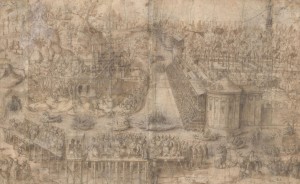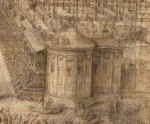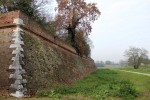A spectacular tournament behind the walls: the Isola beata of 1569
Presented in the ditch that surrounded the defensive tower of the Montagnola, the naval battle of the Isola Beata lit up the night of 25 May 1569 with fireworks, sophisticated scenery, and papier-mâché buildings competed for by sorceresses and sea monsters.
The Plot
This unique event, exceptional from all points of view, was commissioned by Duke Alfonso II d’Este (1533-1597) in honour of his brother-in-law Charles II, Duke of Austria (a Habsburg, brother of Duchess Barbara) who came to visit Ferrara in spring of 1569. The naumachia (naval battle) was held the evening of 25 May in the large moats that surrounded the north-eastern vertex of the city walls, just before the terreplein of the Montagnola dominated by the suggestive Rotonda (the residence built in 1550 by Ercole II d’Este on the walls of the late-fifteenth-century defensive tower).
In addition to a priceless drawing of the theatrical spectacle, we also have a booklet that describes the evolution of the plot in detail, which was mainly focused on a clash between two sorceresses for ownership of a specific territory. The Sorceress of Sorrow controlled and defended an island through an army of Cyclopes and monstrous characters. However, she is outsmarted by the shrewdness of her rival, the Sorceress of Pleasure, who takes advantage of a brief absence to take over the land, seducing six knights as they head towards one of the Elektride islands, eventually pushing them to fight the army of the opponent. After the surrender of the latter, the Sorceress of Pleasure will prodigiously build a palace on the island, taking possession of it. The rival, however, won’t give in so easily, and tries to regain the lost island by heading a fleet of monsters. A battle follows, soon interrupted by the arrival of Eros, the messenger of Venus who will disenchant the knights by inviting them to head towards the Elektride islands, a flourishing district that she is a worthy guardian of:
Come to my beaches, beautiful and pure
a true haven for ladies and knights:
where honour and valour thrive like cardamom and crocus
At this point, the goddess will ask the contenders to stop fighting and to thank Charles of Hapsburg: at the act of deference, the castle naturally dissolves and the island sinks.
The sets, sound effects and a fatal accident
Conceived by the ducal secretary Giovan Battista Pigna, the tournament was directed by Lieutenant Cornelio Bentivoglio. The engineer and mathematician Marco Antonio Pasi from Carpi was responsible for constructing the island, which featured an imposing palace, while the Neapolitan Pirro Ligorio designed the sea monsters, boats and elaborate stage costumes.
The designs found in the Ariostea Library in Ferrara today are a snapshot of a scene during the tournament. On the right is a crowded dais about 80 m long, built on piles, in contact with the curtain wall between the two semicircular defensive towers, with one part covered for the dames and princes. The entire zone was lit by iron fountains full of continuous flames placed on the water, while the island was lit by three rocks per side placed at the end of the beach. Facing the stepped seating is the palace, with the noble yet rustic façade looking out over the beach. Behind it is a hill covered in plants. The most fascinating part of the show was concentrated in the moment the knights passed by, who reached the island on wooden rafts crafted to look like monsters. The procession ends with a shell-shaped boat with the goddess Venus, visible in all her carnal splendour.
In addition to a gentle chorus of nymphs, the soundtrack featured instruments being played while hidden in the bellies of the horrendous mythological creatures. The racket and din of the faux earthquake must have been terrifying, artificially created by mines and other types of explosives hidden within special underground trenches. All the ephemeral buildings were painted by the leading artists of Alfonso's court, including Ludovico Settevecchi, Rinaldo Costabili, Girolamo Bonaccioli and Leonardo da Brescia, while sculptor Ludovico Ranzi made human figures and animal heads out of wicker and plaster. One of the most important figures in attendance was Battista Verato, who was in charge of directing the actors as well as acting in the show himself; Verato was one of the most famous play-actors of the time, and his talents were extolled by the poet Torquato Tasso.
The show was also plagued by a dramatic accident. Dropping down from the walls with weapons and armour, four young, brilliant noble knights from Ferrara caused a ship to flip over and sink, drowning all of its occupants, dragged underwater by the heavy armour. Charles of Hapsburg begged Alfonso II to stop the performance as a sign of mourning, but his brother in law, though pained, wanted the performance to continue to the very end, precisely because the spectacle had been practised numerous times.
Bibliography
- Angelo Solerti, Ferrara e la corte estense nella seconda metà del secolo decimosesto. I discorsi di Annibale Romei gentiluomo ferrarese, Lapi, Città di Castello 1900
- Francesco Ceccarelli, La città di Alcina. Architettura e politica alle foci del Po nel tardo Cinquecento, Il Mulino, Bologna 1998
- Alessandro Marcigliano, Chivalric Festivals at the Ferrarese Court of Alfonso II d’Este, Peter Lang, Bern 2003
- Adriano Cavicchi, Le Cavallerie estensi, in Jadranka Bentini, Cinisello Balsamo (Mi) (a cura di), Gli Este a Ferrara. Una corte nel Rinascimento, catalogo della mostra (Ferrara, marzo-giugno 2004), Silvana Editoriale 2004
Fototeca
Related Themes
Compiling entity
- Assessorato alla Cultura e al Turismo, Comune di Ferrara





